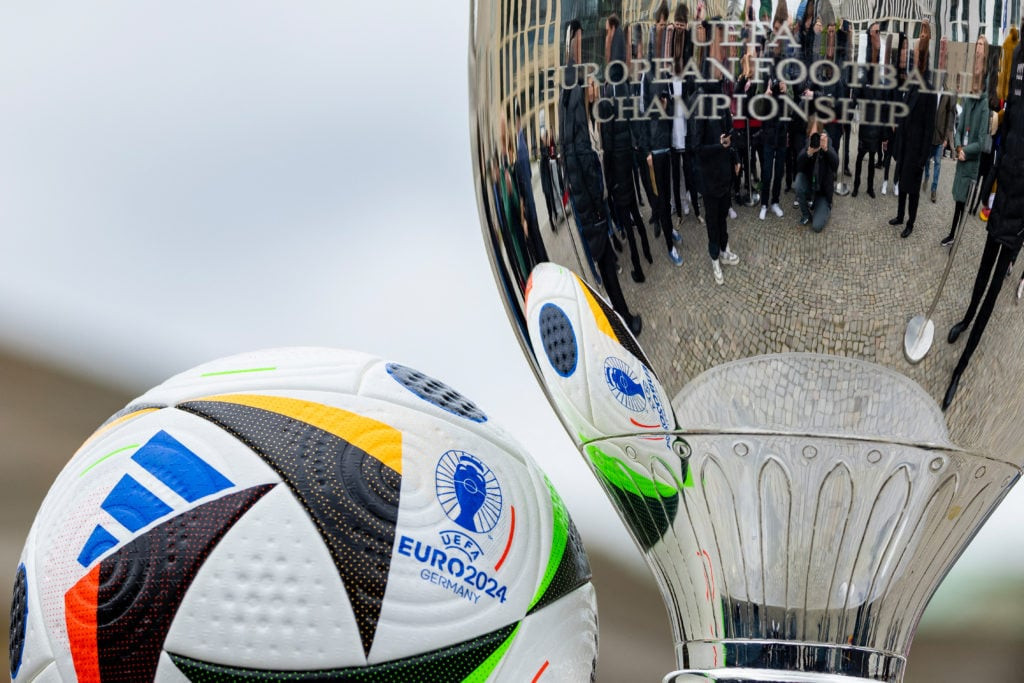Are you puzzled by the term RPS displayed during football broadcasts? This article breaks down what RPS means in football, particularly in the context of UEFA EURO 2024, and why it matters. Learn about the technology behind these measurements and impress your friends with your newfound knowledge, brought to you by CAUHOI2025.UK.COM. Discover football’s spin dynamics.
Decoding RPS in Football: Revolutions Per Second Explained
During UEFA EURO 2024 broadcasts, RPS stands for revolutions per second, indicating the spin rate of the ball after it’s kicked. This metric measures how many times the ball rotates in the air each second, providing insight into the technique and physics behind impressive goals. Analyzing RPS adds a new dimension to understanding a player’s skill and the ball’s trajectory.
What Does RPS Measure?
RPS quantifies the spin imparted on a football. The higher the RPS value, the more spin the ball has. This spin affects the ball’s flight path, making it curve or dip unpredictably, challenging for goalkeepers to anticipate and defend. For example, a knuckleball might have a low RPS because it minimizes spin for a straighter, less predictable trajectory.
How Is RPS Measured?
UEFA EURO 2024 uses the adidas FUSSBALLLIEBE ball, equipped with Connected Ball Technology. This technology tracks various data points, including the ball’s spin rate. Sensors within the ball relay real-time data, allowing broadcasters to display metrics like RPS, ball speed, and distance traveled instantly. This innovation brings advanced analytics to live football coverage.
Why Does RPS Matter in Football?
RPS is crucial because it highlights the skill and technique involved in executing shots. High RPS values often correlate with visually stunning goals that display significant curve or swerve. According to a study published in the Journal of Sports Science and Medicine, a higher spin rate can increase the unpredictability of the ball’s trajectory, making it more difficult for goalkeepers to intercept. This measurement enhances the understanding of player performance and game strategy.
The Technology Behind RPS Measurement
The advent of technologies like the Connected Ball Technology by Adidas has revolutionized how football metrics are captured and analyzed.
Connected Ball Technology
Adidas’s FUSSBALLLIEBE ball includes embedded sensors that measure various parameters, including spin rate, speed, and acceleration. This technology offers a comprehensive view of the ball’s behavior in real-time. According to Adidas, the sensors are designed to be non-intrusive, ensuring that the ball’s performance remains consistent with traditional match balls.
CTR-CORE Technology
In addition to Connected Ball Technology, the FUSSBALLLIEBE ball features CTR-CORE technology in its outer layer. This design enhances accuracy and consistency, supporting precise play with maximum shape and air retention. UEFA notes that this technology is critical for maintaining the ball’s aerodynamic properties throughout the match.
Impact on Broadcasts
These technologies have transformed how broadcasters present football matches. Metrics such as RPS provide deeper insights into the game, offering fans a more analytical perspective. Broadcasters can now highlight the technical skills behind extraordinary goals, making the viewing experience more engaging.
 Photo by ODD ANDERSEN/AFP via Getty Images
Photo by ODD ANDERSEN/AFP via Getty Images
Examples of High RPS Goals
Goals with high RPS values are often memorable moments in football. Here are a few examples where the spin on the ball was a key factor:
Nicolae Stanciu vs. Ukraine (EURO 2024)
During Romania’s 3-0 victory over Ukraine in EURO 2024, Nicolae Stanciu scored a goal measured at 21 RPS. The incredible whip on the ball demonstrated the power and precision Stanciu put into the shot, showcasing how spin can contribute to spectacular goals.
Roberto Carlos Free Kick vs. France (1997)
Roberto Carlos’s free kick against France in 1997 remains one of the most iconic goals in football history, famous for its extreme curvature. While RPS wasn’t measured at the time, the spin imparted on the ball was evident, defying conventional physics and leaving spectators in awe.
Lionel Messi’s Curving Goals
Lionel Messi is known for his ability to curve the ball around defenders and into the net. His technique involves generating high levels of spin, making his shots difficult to predict and defend. Detailed analysis of his goals often reveals exceptional RPS values, reflecting his mastery of ball control.
Why Understanding RPS Enhances the Viewing Experience
Knowing what RPS means can significantly enhance your understanding and enjoyment of football matches.
Deeper Appreciation of Skill
Understanding RPS allows you to appreciate the technical skill and precision involved in executing shots. When you see a high RPS value displayed on screen, you can recognize the player’s ability to manipulate the ball’s trajectory.
Enhanced Analysis
RPS provides a quantitative measure that supports qualitative observations. Rather than simply saying a shot had a lot of curve, you can now see the exact spin rate, adding a layer of analytical depth to your viewing experience. This allows for more informed discussions and debates about player performance.
Engagement with Technology
By understanding the technology behind RPS measurements, you can engage more fully with modern football broadcasts. Knowing how the data is collected and analyzed enriches your understanding of the game’s technical aspects.
Common Football Terminology Explained
Beyond RPS, several other terms are frequently used in football commentary and analysis. Here’s a brief overview:
Pass Completion Rate
The percentage of successful passes a player or team makes during a game. High pass completion rates indicate good ball control and effective teamwork. According to Opta, the top teams in major leagues often have pass completion rates above 85%.
Possession
The amount of time a team controls the ball during a match, usually expressed as a percentage. Higher possession often correlates with greater control over the game, though it doesn’t guarantee victory.
Shots on Target
The number of shots that are aimed at the goal and would have resulted in a goal if not stopped by the goalkeeper or a defender. This metric is a good indicator of attacking intent and efficiency.
Tackles
An attempt to win the ball from an opponent by dispossessing them with a foot or leg. Tackles can be either successful (winning the ball) or unsuccessful (resulting in a foul or missed attempt).
Offsides
A rule that prevents players from gaining an unfair advantage by being closer to the opponent’s goal than both the ball and the second-to-last defender when the ball is passed to them.
Saves
The number of shots on target that a goalkeeper prevents from entering the goal. A high number of saves indicates a strong performance by the goalkeeper.
Assists
A pass or cross that directly leads to a goal. Assists highlight a player’s playmaking abilities and their contribution to the team’s scoring efforts.
Expected Goals (xG)
A statistical measure of the quality of goal-scoring chances created by a team. It calculates the likelihood of a shot resulting in a goal based on factors such as shot angle, distance, and type of assist. This metric provides insight into a team’s attacking efficiency.
| Term | Definition | Relevance |
|---|---|---|
| Pass Completion Rate | Percentage of successful passes made by a player or team. | Indicates ball control and teamwork efficiency. |
| Possession | Amount of time a team controls the ball, expressed as a percentage. | Reflects control over the game, though not a guarantee of victory. |
| Shots on Target | Number of shots aimed at the goal that would have scored if not stopped. | Indicates attacking intent and efficiency. |
| Tackles | Attempts to win the ball from an opponent by dispossessing them with a foot or leg. | Reflects defensive effort and ball-winning ability. |
| Offsides | Rule preventing players from being closer to the opponent’s goal than both the ball and the second-to-last defender. | Ensures fair play and prevents players from gaining an unfair advantage. |
| Saves | Number of shots on target that a goalkeeper prevents from entering the goal. | Indicates goalkeeper’s performance and ability to stop scoring attempts. |
| Assists | Pass or cross that directly leads to a goal. | Highlights playmaking abilities and contribution to scoring efforts. |
| Expected Goals (xG) | Statistical measure of the quality of goal-scoring chances created by a team. | Provides insight into attacking efficiency based on shot quality and likelihood of resulting in a goal. |
Understanding these terms can significantly enhance your ability to follow and analyze football matches.
Frequently Asked Questions (FAQ)
Q1: What is RPS in football?
RPS stands for revolutions per second, measuring the spin rate of the ball after it’s kicked.
Q2: How is RPS measured in modern football?
It’s measured using technology like the Adidas FUSSBALLLIEBE ball with embedded sensors.
Q3: Why is RPS important in football analysis?
It helps analyze the technique behind shots and how spin affects the ball’s trajectory.
Q4: What is Connected Ball Technology?
Connected Ball Technology involves sensors within the ball that track data like spin rate and speed.
Q5: What is CTR-CORE technology?
CTR-CORE is Adidas technology that enhances the ball’s accuracy and shape retention.
Q6: Can high RPS values affect a goalkeeper’s ability to save a shot?
Yes, higher spin rates can make the ball’s trajectory more unpredictable, challenging goalkeepers.
Q7: How does knowing RPS enhance the viewing experience?
It allows for a deeper appreciation of players’ skills and more informed analysis of the game.
Q8: What other football terms are useful to know?
Useful terms include pass completion rate, possession, shots on target, and assists.
Q9: Where can I find reliable information about football statistics?
Reputable sources include Opta, UEFA, and FIFA, as well as sports science journals.
Q10: Why do broadcasters show RPS during UEFA EURO 2024?
To provide viewers with additional insight into the technical aspects of the game and highlight spectacular goals.
Ready to Elevate Your Football IQ?
Understanding football terminology like RPS can transform how you watch and appreciate the game. Do you find yourself constantly searching for clear, reliable explanations of complex sports concepts? At CAUHOI2025.UK.COM, we provide straightforward answers and in-depth analysis on a wide range of topics. Whether you’re curious about advanced football statistics or need help understanding other sports terms, CAUHOI2025.UK.COM is your go-to resource.
Explore CAUHOI2025.UK.COM today to unlock a wealth of knowledge and enhance your understanding of the sports world. If you have more questions, don’t hesitate to reach out or explore our contact page for more information. You can find us at Equitable Life Building, 120 Broadway, New York, NY 10004, USA or call us at +1 (800) 555-0199. Let CauHoi2025.UK.COM be your trusted guide!

